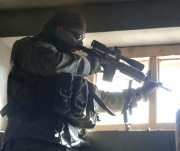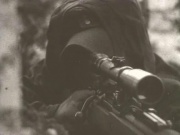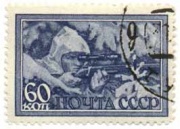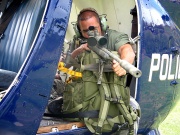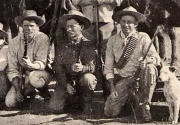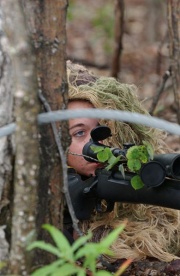Sniper
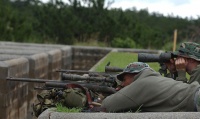
A sniper is a highly trained soldier who specializes in shooting targets with modified rifles from very long distances. They're also adept in stealth, camouflage, infiltration, and observation techniques. Military snipers are also adept at carrying out methods of infiltration, reconnaissance, and observation techniques.[1]
Contents[hide] |
[edit] Etymology
The term sniper was first attested in 1824 in the sense of the word 'sharpshooter'.[2] The verb to snipe originated in the 1770s among soldiers in British India, where a hunter skilled enough to kill the elusive, difficult snipe (a small, fast, wading bird) was dubbed a "sniper". [2]
During the American Civil War, the common term used in the United States, very similar in function to a sniper, was 'skirmisher'. A Civil War army often protected itself by using such soldiers to thwart the enemy from flanking the main body of their attack force.[3] They were deployed individually on the extremes of the moving army primarily to scout for the possibility of an enemy ambush. Consequently, a "skirmish" in this era denotes a clash of small scope between these forces. In general, a skirmish was a limited combat, involving troops other than those of the main body.[3] The term 'sniper' was not in widespread use in the United States until after the American Civil War.
In the last few decades, the term 'sniper' has been used very loosely. Gun control advocates used this term so loosely that some people even called it sniping when a handgun was used; the term 'sniper rifle' was considered very "scary sounding" and was very effective in inciting fear, evoking a lot of unsettling images, such as "a lone gunman, undetectable, on the hunt".[4][5]
The term 'sniper' has been used in more serious tones especially by media in association with police precision riflemen, those responsible for assassination, any shooting from all but the shortest range in war, and any criminal equipped with a rifle in a civil context. In the Bosnian War, and for much of the Siege of Beirut, the term 'sniper' was used to refer to what were generally ill-trained soldiers who terrorized civilians, mainly by firing at them from windows and rooftops. During the Siege of Sarajevo, the main street of the city became known as "Sniper Alley".
This has rather expanded the meaning of the term. It has also given the term 'sniper' mixed connotations. Official sources often use more positive connotative terms to describe snipers, especially for police snipers: counter-sniper, precision marksman, tactical marksman, sharpshooter, precision riflemen, and precision shooter. Some of these alternatives have been in common use for a long time; others are closer to undisguised euphemisms.
[edit] Snipers in warfare
Different countries have different military doctrines regarding snipers in military units, settings, and tactics. Generally, a sniper's primary function in warfare is to provide detailed reconnaissance from a concealed position and, if necessary, to reduce the enemy's fighting ability by striking at a small number of high value targets, especially officers, communication and other personnel.
Soviet Russian and derived military doctrines include squad-level snipers, which may be called “sharpshooters” or “designated marksmen” in other doctrines (see below). They do so because this ability was lost to ordinary troops when assault rifles (which are optimized for close-in, rapid-fire combat) were adopted. See the “Soviet sniper” article for details.
Military snipers from the US, UK, and other countries that adopt their military doctrine are typically deployed in two-man sniper teams consisting of a shooter and spotter. A common practice is for a shooter and a spotter to take turns in order to avoid eye fatigue. German doctrine of largely independent snipers and emphasis on concealment developed during the Second World War have been most influential on modern sniper tactics, currently used throughout Western militaries (examples are specialized camouflage clothing, concealment in terrain and emphasis on coup d'oeil).
Typical sniper missions include reconnaissance and surveillance, target marking for air-strikes, counter-sniper, killing enemy commanders, selecting targets of opportunity, and even anti-matériel tasks (destruction of military equipment), which tend to require use of rifles in the larger calibers such as the .50 BMG. Snipers have of late been increasingly demonstrated as useful by US and UK forces in the recent Iraq campaign in a fire support role to cover the movement of infantry, especially in urban areas.[6]
[edit] Snipers during the First and Second World Wars
[edit] First World War
During the First World War, snipers appeared as deadly sharpshooters in the trenches. At the start of the war, only Imperial Germany had troops that were issued scoped sniper rifles. Although sharpshooters existed on all sides, the Germans specially equipped some of their soldiers with scoped rifles that could pick off enemy soldiers showing their heads out of their trench. At first the French and British believed such hits to be coincidental hits, until the German scoped rifles were discovered. During World War One, the Germans received a reputation for the deadliness and efficiency of their snipers, partly because of the high-quality lenses the Germans could manufacture. Soon the British army began to train their own snipers in specialized sniper schools. Until the end of the war, the British tried to close the gap between the German and their own snipers. British and German sniper teams operated in pairs, with one sniper and one spotter with binoculars. On the Eastern Front, Imperial Russia never introduced specialized sharpshooters or snipers, allowing the German snipers to pick off their targets without danger from counter-snipers.
[edit] Second World War
[edit] European Theater
During the Second World War, snipers reappeared as important factors on the battlefield. During the interbellum, most nations had dropped their specialized sniper units, notably the Germans who had had such a reputation during the First World War. However, during the Spanish Civil War, the effectiveness and dangers of snipers once again came to the fore. The only nation that had specially trained sniper units during the 1930's was the Soviet Union, mostly because of their involvement in Spain. Soviet snipers were trained in their skills as marksmen, in using the terrain to hide themselves from the enemy and the ability to work alongside regular forces. This made the Soviet sniper training focus more on 'normal' combat situations than those of other nations. During the 1940 campaigns of Germany, it appeared that lone, well hidden snipers could halt the German advance for a significant amount of time. For example during the close-in on Dunkirk, British snipers were able to significantly delay German infantry trying to reach Dunkirk. This prompted the British to once again upscale their training of specialized sniper units. British snipers were trained in the obvious marksmanship skills and taught to blend in with the environment, often by using special headgear that concealed them. However, the British Army offered sniper training exclusively to officers and non-commissioned officers, which reduced their effectiveness considerably.
One of the best known battles involving snipers, and also the battle that made the Germans reinstate their specialized sniper training, was the Battle of Stalingrad. Their defensive position inside a city filled with rubble meant that Soviet snipers were able to inflict significant casualties on the German Wehrmacht. Because of the urban nature of fighting, snipers were very hard to spot and seriously dented the morale of the German attackers. Though German sharpshooters appeared spontaneously, often armed with captured scoped Mosin-Nagant rifles, Germany re-established its own sniping school and set out to reclaim its reputation of the First World War. Germany drastically increased the number of snipers per unit. German training emphasized shooting at long-range targets to deliver a feeling of insecurity to the enemy, the ability to creep up on enemies and maintain hidden with enemies nearby, plus especially good camouflaging. Germany evolved the most efficient ways of camouflaging, both by using the environment (branches etc.) and by the development of specially designed, reversible camouflage clothing. German snipers were also issued with special shovels and knives to create the best possible hiding places and shelters. As they had done during the First World War, German snipers also changed location after a few shots to further reduce their chances of being spotted. They were also issued highest-quality adjustable scopes (Soviet scopes were not adjustable).
In the United States armed forces, sniper training was only very elementary and focused on being able to hit targets over long distances. Snipers were required to be able to hit a body over 400 meters, and a head over 200. There was almost no concern with the ability to blend into the environment. Sniper training also varied from place to place, resulting in a wide range of qualities of snipers. The main reason the US did not extend their training beyond long-range shooting was the limited employment of US soldiers until the Normandy Invasion. During the campaigns in North Africa and Italy, most fighting occurred in arid and mountainous regions where limited concealment was possible, in contrast to Western and Central Europe. This made for disaster in Normandy and the rest of the campaign in Western Europe, where they encountered the well trained German snipers. In Normandy, German snipers remained hidden in the dense vegetation and were able to encircle American units, firing at them from all sides. The American and British forces were surprised by how near the German snipers could come and safely attack them, as well as by their ability to hit targets over long distances. A famous mistake made by the green American soldiers was to lie down and wait when targeted by German snipers, this allowed the snipers to pick them off one after another. Often German snipers infiltrated Allied lines, and sometimes when the front had moved away, they fought from their hiding places until they were out of rations or ammunition and tried to surrender.
After the war, many elements of German sniper training and doctrine were copied by other countries.
[edit] Pacific Theater
In the Pacific War, the Empire of Japan also trained snipers. In the jungles of Asia and the Pacific Islands, snipers posed a serious threat to the British, Australian, Canadian and US troops. Japanese snipers were specially trained to use the environment to conceal themselves. Japanese snipers used foliage on their uniforms and dug well-concealed hide-outs that were often connected with small trenches. There was no need for long range accuracy, because most combat in the jungle took place within a few hundred meters. Japanese snipers were known for their patience and ability to remain hidden for long periods. However, they almost never left their carefully camouflaged hiding spots. This resulted partly from their training and partly from their fighting mentality, the Japanese fought until death and would seldom retreat. This meant that whenever a sniper was in the area, the location of the sniper was known after a few shots. It also meant a continuous lowering of the quality of Japanese snipers. The Allies also used their own snipers in the Pacific, notably the US Marines, who used a Springfield rifle with elongated scope that allowed for very long range shooting.
[edit] Common sniper rifles used during World War II
Some common sniper rifles used during the Second World War include: the Soviet M1891/30 Mosin Nagant and, to a lesser extent, the semi-automatic SVT-40; the German Mauser Kar 98k and semi-automatic Gewehr 43; the British Lee-Enfield No. 4; the Japanese Arisaka 97; and the American M1903 Springfield.
[edit] Range
The longest range recorded for a sniper kill currently stands at 2,430 meters (2,657 yd, or 1.51 miles), accomplished by Corporal Rob Furlong, a sniper from Newfoundland, Canada, in March 2002 during the war in Afghanistan. Corporal Rob Furlong made this record-breaking kill while he was participating in Operation Anaconda. He was serving with Princess Patricia's Canadian Light Infantry (PPCLI) at the time. To make the kill, he used a .50 caliber BMG (12.7 mm) McMillan TAC-50 bolt-action rifle.[7]
If one takes the time-in-flight of the bullet with air resistance to be conservatively about 1.5× the flight time without air resistance, that would be about 4.5 seconds (2,430m ÷ 823m/s[8] = 2.95s). Over that time, neglecting any aerodynamic lift on the bullet in flight, it would drop almost 100m on its way to the target.
The previous record was held by U.S. Marine sniper Carlos Hathcock in February 1967 during the Vietnam War, at a distance of more than 2,500 yards using a scope-mounted Browning M2 .50 machine gun.[9][10][11]
By contrast, much of the US/Coalition urban sniping in support of operations in Iraq is at much shorter ranges, although in one notable incident on April 3 2003, Corporals Matt and Sam Hughes, a two-man sniper team of the Royal Marines, armed with L96 sniper rifles each killed targets at a range of about 860 metres (941 yd) with shots that, due to strong wind, had to be “fire[d] exactly 17 meters (56 ft) to the left of the target for the bullet to bend in the wind.”[12]
During Operation Enduring Freedom, Spanish Navy Marine snipers shot cables hanging from the mast to the bridge of the North-Korean freighter So San, smuggling Scud missiles through the waters of Socotra Island. These cables were preventing it from being boarded by fast rope for an arms inspection. The shots were made at a range of 400 yards,with rough sea, from the deck of a Santa Maria class frigate, and the Marines were armed with Barrett M95 rifles.
[edit] Police
Law enforcement snipers, also commonly called police snipers, and military snipers, differ in many ways, including their areas of operation, training, and tactics. A police sharpshooter is part of a police operation and usually takes part in relatively short missions. Police forces typically deploy such sharpshooters in hostage scenarios. This differs from a military sniper, who operates as part of a larger army, engaged in warfare. Often as part of a SWAT team, police snipers are deployed alongside negotiators and an assault team trained for close quarters combat. As policemen, they are trained to shoot only as a last resort, when there is a direct threat to life; the police sharpshooter has a well-known rule: "Be prepared to take a life to save a life."[13] Police snipers typically operate at much shorter ranges than military snipers, generally under 100 metres (109 yd) and sometimes even less than 50 metres (55 yd). Both types of snipers do make difficult shots under pressure, and often perform one shot kills.
Police units which are unprepared for tactical operations may rely on a specialized SWAT tactical team, which may have a dedicated sniper team member.[13]
Some police sniper operations begin with military assistance.[14]
Police snipers placed in vantage points, such as high buildings, can provide security for events.[15]
The need for specialized training for police sharpshooters was made apparent in 1972 during the Munich massacre when the German police could not deploy specialized personnel or equipment during the standoff at the airport in the closing phase of the crisis, and consequently all of the Israeli hostages were killed. The use of snipers of the German army was impossible due to the German constitution's explicit prohibition of the use of the military in domestic matters. This situation was later addressed with the founding of the specialized police counter-terrorist unit GSG 9.
In one high-profile incident, a SWAT sniper in Columbus, Ohio prevented a suicide by shooting a revolver out of the individual's hand, leaving him unharmed.[16]
[edit] Training
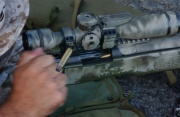
Good training is essential to provide a sniper with the skills needed to perform well. Military sniper training aims to teach a high degree of proficiency in camouflage and concealment, stalking and observation as well as precision marksmanship under various operational conditions. Trainees typically shoot thousands of rounds over a number of weeks, while learning these core skills.
Snipers are trained to squeeze the trigger straight back with the ball of their finger, to avoid jerking the gun sideways. The most accurate position is prone, with a sandbag supporting the stock, and the stock's cheek-piece against the cheek. In the field, a bipod can be used instead. Sometimes a sling is wrapped around the weak arm (or both) to reduce stock movement. Some doctrines train a sniper to breathe deeply before shooting, then hold their lungs empty while they line up and take their shot. Some go further, teaching their snipers to shoot between heartbeats to minimize barrel motion.
[edit] Consistency
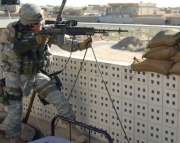
The key to sniping is consistency, which applies to both the weapon and the shooter. The consistency of a sniper rifle is how precise the bullet travels from the rifle to its target when fired. While consistency does not necessarily ensure accuracy (which requires training), sniping cannot be accurately carried out without it.
Although there is always a degree of randomness due to physics and the nature of bullets, a precision sniping rifle must limit this effect. When fired from a fixed position, all shots must be extremely close together, even at long range. Similarly, a sniper must have the ability to estimate the range of the target, the velocity of the wind, the altitude and elevation of the sniper and the target, the temperature of the environment and gun barrel, and any other major factors that can alter the shot. Mistakes in estimation compound over distance and can decrease lethality or cause a shot to miss completely.
Snipers generally prefer to zero their weapons at a target range, although it can also be done in the field. This is where the sniper calibrates his rifle with his scope at a particular range (typically at the most common encounter distance) such that shots will reliably strike their target. A rifle must maintain its zero in the field, or else it must be re-zeroed before the next encounter. Once zeroed, the rifle can be adjusted for other distances or for wind using estimates, calculations, and scope features.
The military need for consistency is highest when a sniper is firing the first shot against an enemy unaware of the sniper's presence. At this point, high-priority targets such as enemy snipers, officers, and critical equipment are most prominent and can be more accurately targeted. Once the first shot has been fired, any surviving enemy will attempt to take cover or locate the sniper, and attacking strategic targets becomes more difficult.
The need for police sniper consistency is high when in a hostage situation. Firing a shot but failing to immediately incapacitate an armed threat is likely to result in the death of hostages, and cause the aggressor to cease negotiations and retreat to cover. In this situation, lives can depend on the result of a single shot, and it is this pressure that police snipers must overcome when firing.
A sandbag serves as a useful platform for shooting a sniper rifle. In the field, a bipod is more common, although any soft surface such as a rucksack will steady a rifle and contribute to consistency. In particular, bipods help when firing from a prone position, and enable the firing position to be sustained for an extended period of time. Many police and military sniper rifles come equipped with an adjustable bipod.
[edit] U.S. military
Snipers are volunteers accepted for sniper training on the basis of their aptitude as perceived by their commanders. Military snipers may be trained as Forward Air Controllers (FACs) to direct military air strikes, as Forward Observers (FOs) in artillery target indication, or as mortar fire controllers (MFCs).
Effective sniping in a military context may necessitate assuming a stationary position for days at a time. Fatigue and muscle stiffness often result from the mandatory immobility. Also, urination and defecation into a bag or other container may become essential.
[edit] British military
The first British sniper unit began life as Lovat Scouts, a Scottish Highland regiment that earned high praise during the Second Boer War. The unit was formed by Simon Fraser, 14th Lord Lovat and reported to an American, Major Frederick Russell Burnham, the British Army Chief of Scouts under Lord Roberts. Burnham fittingly described these scouts as "half wolf and half jackrabbit."[17] Just like their Boer opponents, they were well practiced in the arts of marksmanship, field craft, and military tactics. They were also the first known military unit to wear a ghillie suit.[18] They were skilled woodsmen but also practitioners of discretion: "He who shoots and runs away, lives to shoot another day." After the war, this regiment went on to formally become the British Army's first sniper unit, then better known as sharpshooters.[17]
[edit] Targeting
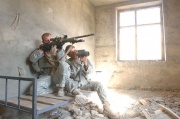
The range to the target is measured or estimated as precisely as conditions permit and correct range estimation becomes absolutely critical at long ranges, because a bullet travels with a curved trajectory and the sniper must compensate for this by aiming higher at longer distances. If the exact distance is not known the sniper will compensate incorrectly and the bullet path will be too high or low. As an example, for a typical military sniping cartridge such as 7.62 × 51 mm NATO (.308 winchester) M118 Special Ball round this difference (or “drop”) from 700 metres (766 yd) to 800 metres (875 yd) is 200 mm (8 in). This means that if the sniper incorrectly estimated the distance as 700 m (766 yd) when the target was in fact 800 m (875 yd) away, the bullet will be 200 mm (8 in) lower than expected by the time it reaches the target.
Laser rangefinders may be used, but are not preferred on the battlefield because a laser can be seen by both the sender and the receiver. One useful method is comparing the height of the target (or nearby objects) to their size on the mil dot scope, or taking a known distance and using some sort of measure (utility poles, fence posts) to determine the additional distance. The average human head is 150 mm (6 in) in width, average human shoulders are 500 mm (20 in) apart and the average distance from a person's crotch to the top of their head is 100 cm (39.4 in).
To determine the range to a target without a laser rangefinder, the sniper must use the mil dot reticle on a scope to accurately find the range. Mil dots are used like a slide rule to measure the height of a target, and if the height is known, the range can be as well. The height of the target (in yards) ×1000, divided by the height of the target (in mils), gives the range in yards. This is only in general, however, as both scope magnification (7×, 40×) and mil dot spacing change. The USMC standard is that 1 mil (that is, 1 milliradian) equals 3.438 MOA (minute of arc, or, equivalently, minute of angle), while the US Army standard is 3.6 MOA, chosen so as to give a diameter of 1 yard (36 inches) at 1,000 yards (1,000 m). Many commercial manufacturers use 3.5, splitting the difference, since it is easier with which to work.
Explanation: 1 MIL = 1 milli-radian. That is, 1 MIL = 1x10^-3 radian. But, 10^-3 rad x (360 deg/ (2 x Pi) radians) = 0.0573 degrees. Now, 1 MOA = 1/60 degree = 0.01667 degrees. Hence, there are 0.0573/0.01667 = 3.43775 MOA per MIL, where MIL is defined as a milli-radian. On the other hand, defining a mil-dot by the US Army way, to equate it to 1-yard (1 m) at 1,000 yards (1,000 m), means the Army's mil-dot is approximately 3.6 MOA.
It is important to note that angular mil (mil) is only an approximation of a milliradian and different organizations use different approximations. Please see three definitions of the angular mil.
At longer ranges, bullet drop plays a significant role in targeting. The effect can be estimated from a chart which may be memorized or taped to the rifle, although some scopes come with Bullet Drop Compensator (BDC) systems that only require the range be dialed in. These are tuned to both a specific class of rifle and specific ammunition. It must be noted that every bullet type and load will have different ballistics. .308 Federal 175 grain (11.3 g) BTHP match shoots at 2,600 ft/s (790 m/s). Zeroed at 100 yards (100 m), a 16.2 MOA adjustment would have to be made to hit a target at 600 yards (500 m). If the same bullet was shot with 168 grain (10.9 g), a 17.1 MOA adjustment would be necessary.
Shooting uphill or downhill can require more adjustment due to the effects of gravity. Wind also plays a significant role, the effect increasing with wind speed or the distance of the shot. The slant of visible convections near the ground can be used to estimate crosswinds, and correct the point of aim. Recently, a small device known as a cosine indicator has been developed. This device is clamped to the tubular body of the telescopic sight, and gives an indicative readout in numerical form as the rifle is aimed up or down at the target. This is translated into a figure used to compute the actual range to the target.
All adjustments for range, wind, and elevation can be performed by “holding over” by eye, also known as Kentucky windage. The most accurate way is called “dialing in” the scope. This adjusts the scope so that the crosshairs point at the target, while also accounting for the effect of the factors above. With precision mechanics, dialing in is more accurate, as the eye can more easily line up and hold the target.
For moving targets, the point of aim is in front of the target. This is known as “leading” the target, where the amount of lead depends on the speed and angle of the target's movement. For this technique, holding over is the preferred method. Anticipating the behavior of the target is necessary to accurately place the shot.
[edit] Sniper equipment
- Main article: Sniper equipment
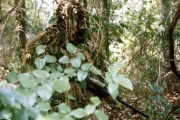
The major components of a sniper's equipment include a sniper rifle, ammunition, suppressor, camouflage, and/or a ghillie suit.
[edit] Sniper tactics
[edit] Shot placement
Shot placement varies considerably with the type of sniper being discussed. Military snipers, who generally do not engage targets at less than 300 m (330 yd), usually attempt body shots, aiming at the chest. These shots depend on tissue damage, organ trauma, and blood loss to make the kill.
Police snipers who generally engage at much shorter distances may attempt more precise shot at particular parts of body or particular devices: in one event in 2007 in Marseille, a GIGN sniper took a shot from 80 m (87 yd) at the pistol of a policeman threatening to commit suicide, destroying the weapon and preventing him from killing himself.[19] Less lethal shots (at arms or legs) may also be taken at criminals to sap their will to fight or reduce their mobility. In a high risk situation police snipers may take head shots to ensure an instant kill. In instant-death hostage situations, police snipers shoot for the cerebellum, a part of the brain that controls voluntary movement that lies at the base of the skull. Some ballistics and neurological researchers have argued that severing the spinal cord at an area near the second cervical vertebra is actually achieved, usually having the same effect of preventing voluntary motor activity, but the debate on the matter remains largely academic at present.
[edit] Targets
Snipers can target personnel or materiel, but most often they target the most important enemy personnel such as officers or specialists (e.g. communications operators) so as to cause maximum disruption to enemy operations. Other personnel they might target include those who pose an immediate threat to the sniper, like dog handlers, who are often employed in a search for snipers.
A sniper identifies officers by their appearance and behavior such as symbols of rank, talking to radio operators, sitting as a passenger in a car, having military servants, or talking and moving position more frequently. If possible, snipers shoot in descending order by rank, or if rank is unavailable, they shoot to disrupt communications.
Since most kills in modern warfare are by crew-served weapons, reconnaissance is one of the most effective uses of snipers. They use their aerobic conditioning, infiltration skills and excellent long-distance observation equipment and tactics to approach and observe the enemy. In this role, their rules of engagement let them engage only high value targets of opportunity.
Some rifles, such as the Denel NTW-20 are designed for a purely anti-materiel (AM) role, e.g. shooting turbine disks of parked jet fighters, missile guidance packages, expensive optics, and the bearings, tubes or wave guides of radar sets. A sniper equipped with the correct rifle can target radar dishes, water containers, the engines of vehicles, and any number of other targets. Other rifles, such as the .50 calibre rifles produced by Barrett and McMillan are not designed exclusively as AM rifles, but are often employed in such a way, providing the range and power needed for AM applications in a lightweight package compared to most traditional AM rifles. Other calibers, such as the .408 Cheyenne Tactical and the .338 Lapua are designed to be capable of limited AM application, but ideally suited as anti-personnel rounds.
[edit] Relocating
Often in situations with multiple targets, snipers must use a special kind of tactic. After firing a few shots from a certain position, snipers are known to move unseen to another location before the enemy can figure where he is and mount a counterattack. Snipers will frequently use this tactic to their advantage, creating an atmosphere of chaos and confusion. An experienced marksman will make it seem as if an entire squad of snipers is engaging the targets. In sniper jargon, this is known as "relocating".
[edit] Sound masking
As sniper rifles are often extremely powerful and loud, it is common for snipers to use a technique known as sound masking. This tactic, in the hands of a highly skilled marksman, can be used as a substitute for a noise suppressor. Very loud sounds in the environment, such as artillery shells air bursting or claps of thunder, can often mask the sound of the shot. This technique is frequently used in clandestine operations and infiltration tactics.
[edit] Psychological warfare
Due to the without-warning aspect of sniper shot, high lethality of aimed shots and frustration of aimed troops not able to shoot back because they can't locate the sniper or it is out of their range sniper tactics have a significant effect on morale. Extensive use of sniper tactics can be used as a psychological strategy in order to induce constant stress in opposing forces.
One may note that by many aspects (constant threat, high "per event" lethality, inability to strike back), psychological impact is quite similar to those of mines,booby-trap or IEDs.
Only during the 20th century have snipers been considered heroes of war, and before were often given names such as "Filthy dogs", "Devil Rats" and "Bottom feeders" due to their inability to be seen or caught. Credit for this reputation traces to the American Revolution, when American "Marksmen" would intentionally target British officers, an act considered uncivilized by the British Army at the time (this reputation would be cemented during the Battle of Saratoga, when Benedict Arnold allegedly ordered his marksmen to target British General Simon Fraser, an act that would win the battle and French support). However, the British side used specially selected sharpshooters as well, often German mercenaries.
To demoralize enemy troops, snipers can follow predictable patterns. During the Cuban Revolution, the 26th of July Movement always killed the foremost man in a group of Batista's soldiers. Realizing this, none of them would walk first, as it was suicidal. This effectively decreased the army's willingness to search for rebel bases in the mountains. An alternative approach is to kill the second man in a row, leading to the psychological effect that nobody will want to follow the "leader" on first position.
The phrase "one shot, one kill" has gained notoriety in popular culture as a glorification of the "sniper mystique." The phrase embodies the sniper's tactics and philosophy of stealth and efficiency. The exact meaning can be explained thus:
- A single round should be fired, avoiding unnecessary and indiscreet firing
- Every shot should be accurately placed
Whether the phrase actually reflects reality is of course subject to debate, but it has been widely used in literature and movies.
[edit] Counter-sniper tactics
- Main article: Counter-sniper tactics
The occurrence of sniper warfare has led to the evolution of many counter-sniper tactics in modern military strategies. These aim to reduce the damage caused by a sniper to an army, which can often be harmful to both fighting capabilities and morale.
The risk of damage to a chain of command can be reduced by removing/concealing features which would otherwise indicate an officer's rank. Armies nowadays tend to avoid saluting officers in the field and eliminate rank insignia on BDUs. Officers can seek maximum cover before revealing themselves as good candidates for sniping through actions like reading maps and using radios.
Friendly snipers can be used to hunt the enemy sniper. Besides direct observation, defending forces can use other techniques. These include calculating the trajectory of a bullet by triangulation. Traditionally, triangulation of a sniper's position was done manually, though radar-based technology has recently become available. Once located, the defenders can try to approach the sniper from cover and overwhelm him. The United States military is funding a project known as RedOwl, which uses laser and acoustic sensors to determine the exact direction from which a sniper round has been fired.[20]
The more shots a sniper fires, the more chances the defenders have to locate him, so they often try to draw fire, sometimes by offering a helmet slightly out of concealment. A tactic successfully employed in the Winter War by the Finns is known as "Kylmä-Kalle" (Cold Charlie). They used a shop mannequin or other doll dressed as a tempting target, like an officer. The doll was then presented as if it were a real man sloppily covering himself. Usually, Soviet snipers were unable to resist the temptation of an apparently easy kill. Once the angle where the bullet came from was determined, a shot of a large calibre gun such as a Lahti L-39 "Norsupyssy" ("Elephant rifle") anti-tank rifle was shot at the sniper's direction to eliminate him.
Other tactics include directing artillery or mortar fire onto suspected sniper positions, the use of smoke screens, and placing tripwire-operated munitions, mines, or other booby-traps near suspected sniper positions. Even dummy trip-wires can be placed to inconvenience sniper movement. Where anti-personnel mines are unavailable, it is possible to improvise booby-traps by connecting trip-wires to hand grenades, smoke grenades or flares. Even though these may not kill the sniper, they will reveal his location. Booby-trap devices should be placed close to likely sniper hides or along the probable routes used into and out of the sniper's work area. Knowledge of sniper field craft will assist in this task.
One very old counter-sniper tactic is to tie rags onto bushes or similar items in a danger area. The rags flutter in the breeze creating random movements in the corner of the sniper's eye, which they find distracting. The main virtue of this tactic is that it is easy to use, though it will definitely not stop a professional sniper from selecting targets, and may in fact provide a sniper with additional information about the wind near the target.
The use of canine units was also very successful, especially during the Vietnam War. A trained dog can easily determine the direction of the sniper from the sound of the bullet and will lie down with his head aiming at the sniper to give his handler the direction of the firing.
[edit] Snipers in irregular and asymmetric warfare
- Main article: Asymmetric warfare
The use of sniping (in the sense of shooting at relatively long range from a concealed position) to murder came to public attention in a number of sensational U.S. cases, including the Austin sniper incident of 1966, the John F. Kennedy assassination, and the Beltway sniper attacks of late 2002. However, these incidents usually do not involve the range or skill of military snipers; in all three cases the perpetrators had U.S. military training, but in other specialties. News reports will often (inaccurately) use the term sniper to describe anyone shooting with a rifle at another person.
Sniping has also been used in asymmetric warfare situations, for example in the Northern Ireland Troubles, where in the early 1970s a number of soldiers were shot by concealed riflemen, some at considerable range. There were also some instances in the early 1990s of British soldiers being shot with .50 caliber Barrett rifles by sniper teams collectively known as the South Armagh sniper. In Northern Ireland, in addition to the uses listed above, a sniper was quite often a form of bait called a "come-on", whereby the sniper's position would be made obvious to a British patrol so as to draw them into an ambush in their attempt to close with the sniper.
The sniper is particularly suited to combat environments where one side is at a disadvantage. A careful sniping strategy can use a few individuals and resources to thwart the movement or other progress of a much better equipped or larger force. Because of this perceived difference in force size, the sniping attacks may be viewed as the act of a few persons to terrorize (earning the moniker 'terrorists') a much larger, regular force — regardless of the size of the force the snipers are attached to. These perceptions stem from the precept that sniping, while effective in specific instances, is much more effective as a broadly deployed psychological attack (see elsewhere in article).
In the civil war between Bosnian Muslim, Croatian forces, and Bosnian Serbs in the early 1990s, Serbian snipers in Sarajevo used sniping as a terror tool by shooting at any person, whether military or civilian, adult or child. These snipers would be classified as war criminals for deliberately targeting non-combatants.
Snipers are less likely to be treated mercifully if captured by the enemy. The rationale for this is that ordinary soldiers shoot at each other at 'equal opportunity' whilst snipers take their time in tracking and killing individual targets in a methodical fashion.
[edit] War in Iraq
In 2003, the U.S.-led multinational coalition composed of primarily U.S. and U.K. troops occupied Iraq and attempted to establish a new democratic government in the country. However, shortly after the initial invasion, violence against coalition forces and among various sectarian groups led to asymmetric warfare with the Iraqi insurgency, civil war between many Sunni and Shia Iraqis, and al-Qaeda operations in Iraq.
Through November 2005, when the Pentagon had last reported a sniper fatality, the Army had attributed 28 of 2,100 U.S. deaths to enemy snipers.[21] More recently in 2006, insurgent snipers such as the "Juba" have caused problems for American troops, where it was claimed the "Juba" had shot 37 American soldiers in Iraq as of October 2006.[22]
In 2006, training materials obtained by U.S. intelligence showed that snipers fighting in Iraq were urged to single out and attack engineers, medics, and chaplains on the theory that those casualties would demoralize entire enemy units.[23] Among the training materials, there included an insurgent sniper training manual that was posted on the Internet. Among its tips for shooting U.S. troops, there read: "Killing doctors and chaplains is suggested as a means of psychological warfare."[21]
[edit] Selected snipers in history
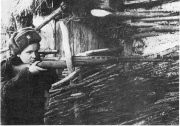
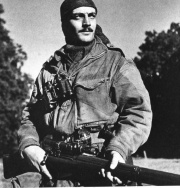
Even before firearms were available, soldiers such as archers were specially trained as elite marksmen.
[edit] Before the 20th century
- Ninja or Shinobi (16th century Japan) – supposedly trained to cover retreating armies, targeting officers from concealed positions. One of Japan's most famous warlords, Takeda Shingen, was possibly fatally wounded by a sniper.[24]
- Lord Brooks, who represented the Parliamentarians in the English Civil War, was the first recorded British sniper victim.
- Timothy Murphy (American Revolutionary War) – killed British General Simon Fraser during the pivotal Battle of Saratoga, hampering the British advance and causing them to lose the battle.
- Patrick Ferguson (American Revolutionary War) - developer of the world's first breech-loaded military rifle (which advanced sniping and sharpshooting tactics), fought with his Corps of Riflemen (recruited from the 6th and 14th Foot) at the Battle of Brandywine, where he may have passed up a chance to shoot George Washington.[25]
- Napoleonic Wars – Use of Marine sharpshooters in the mast tops was common usage in navies of the period, and Admiral Nelson's death at Trafalgar is attributed to the actions of French Sharpshooters. The British Army developed the concept of directed fire (as opposed to massive unaimed volleys) and formed Rifle regiments, famously the 95th and the 60th who wore green jackets instead of the usual redcoats. Fighting as Skirmishers, usually in pairs and trusted to choose their own targets, they wrought havoc amongst the French during the peninsular war against Napoleon's Forces.
- British Rifleman Thomas Plunkett (Peninsular war) – shot French General Auguste-Marie-François Colbert at a range of between 200 metres (219 yd) and 600 metres (656 yd) using a Baker rifle.[26]
- Colonel Hiram Berdan (American Civil War) – commanded 1st and 2nd US Sharpshooters, who were trained and equipped Union marksmen with the .52 caliber Sharps Rifle. It has been claimed that Berdan's units killed more enemies than any other in the Union Army.
- Sgt. Grace (American Civil War) – sniped Major General John Sedgwick at the then incredible distance of 730 m (800 yd) during the Battle of Spotsylvania Court House, with a British Whitworth target rifle causing administrative delays in the Union's attack, leading to Confederate victory. Sedgwick ignored advice to take cover, his last words according to urban legend being, "They couldn't hit an elephant at this dist-" upon which he was shot. In reality, he was shot a few minutes later.
- Major Frederick Russell Burnham - assassinated Mlimo, the Ndebele religious leader, in his cave in Matobo Hills, Rhodesia, effectively ending the Second Matabele War (1896). Burnham started as a cowboy and Indian tracker in the American Old West, but he left the United States to scout in Africa and went on to command the British Army Scouts in the Second Boer War. For his ability to track, even at night, the Africans dubbed him, He-who-sees-in-the-dark, but in the press he became more widely known as England's American Scout.
[edit] 20th century
- Billy Sing (Gallipoli Campaign, World War I) - killed between 150 and 201 Turkish soldiers.
- Francis Pegahmagabow (World War I) - Native Canadian sniper credited with 378 kills
- The Finnish Korpraali (Lance Corporal) Simo Häyhä 'Valkoinen Kuolema' (the White Death) was a sniper during the (Winter War) and is regarded by many as the most effective sniper in the history of warfare, being credited with killing up to 542 Soviet soldiers (an average of 5 a day) using a SAKO m/28-30 (Pystykorva) and iron sights.
- Junior Lieutenant Vasily Zaytsev (World War II) – credited with killing 225 German officers and soldiers during the Battle of Stalingrad; subject of the film Enemy at the Gates and the book War of the Rats, both fictionalized accounts. His total number of verified kills was 242, but some argue it was more than 400.[27]
- Gefreiter (Private) Matthias Hetzenauer (World War II) - Austrian sniper who was credited with 345 kills on the Eastern Front, the most successful in the Wehrmacht.
- Obergefreiter (Private First Class) Josef 'Sepp' Allerberger (World War II) - Austrian sniper credited with 257 kills on the Eastern Front.
- Lieutenant Lyudmila Pavlichenko (World War II) – female sniper with 309 confirmed kills, making her the most successful female sniper in history.
- Gunnery Sergeant Carlos Hathcock (Vietnam war) – achieved 93 confirmed kills. He held the record of longest confirmed kill at a distance of 2,250 m (2,460 yd) (made with a scoped M2 Browning machine gun) for 35 years until 2002.[9][10][11]
- Chuck Mawhinney (Vietnam war) – 103 confirmed and 216 probable kills.
- Adelbert F . Waldron (Vietnam war) – achieved 109 confirmed kills.
- Master Sgt. Gary Gordon and Sgt. First Class Randy Shughart - Operation Gothic Serpent - Delta Force snipers awarded the Medal of Honor for their actions protecting the injured crew of a downed helicopter during the Battle of Mogadishu. Dramatized in the film Black Hawk Down.
- Mikhail Surkov - the top Soviet sniper according to the number of confirmed eliminated enemies (702).
[edit] 21st century
- PPCLI Canadian Soldier Corporal Rob Furlong (Operation Anaconda, Afghanistan) - holds the record for the longest-ever recorded and confirmed sniper kill at 2,430 meters (1.509 miles) using a .50 caliber (12.7 mm) McMillan TAC-50 rifle.[7][28]
- Juba (Arabic: جوبا) (a.k.a. "Joba") is the nom de guerre of an alleged sniper involved in the Iraqi insurgency featured in several videos of Iraqi insurgents in action. It was claimed he had shot 37 American soldiers.
[edit] See also
- Designated marksman
- Scout Sniper
- Urban sniper
- Snipers of the Soviet Union
- Adopt a Sniper
- Anti-tank rifle
[edit] References
- ↑ How Military Snipers Work - What Does a Sniper Really Do? Valdes, Robert; Howstuffworks.com
- ↑ 2.0 2.1 Online Etymology Dictionary - Snipe
- ↑ 3.0 3.1 Definitions of Civil War Terms January 4, 2007
- ↑ Assault Weapons - Sniper Rifles Joe Huffman, February 7, 2008
- ↑ How Military Snipers Work Howstuffworks.com. "For most of us, the word "sniper" evokes some unsettling imagery -- a lone gunman, undetectable, on the hunt."
- ↑ 02-Jan-2008 version: Section "Snipers during the First and Second World Wars": info taken from: Zeitgeschichte - Spezialeinheiten im Zweiten Weltkrieg: Scharfschützen German Documentary (EAN: 4020974153959)
- ↑ 7.0 7.1 "World longest distance kill - 2,430 meters (1.5 miles)". Stupid Beaver (April 2007). “Canadian snipers in Afghanistan after September 11th made the longest recorded kills in history with this weapon. On a March afternoon in 2002, Cpl. Furlong of the Princess Patricia's Canadian Light Infantry (PPCLI) squinted through the scope of his McMillan TAC-50 and successfully killed an enemy combatant from 2,430 m.”
- ↑ http://mcmfamily.com/pdfs/Tac-50%20Technical%20Data.pdf
- ↑ 9.0 9.1 "...famous Hathcock shot that killed an enemy from more than 2,500 yards away..." Marine Corps News March 29, 2007 - Range complex named after famous Vietnam sniper http://www.marines.mil/marinelink/mcn2000.nsf/lookupstoryref/2007329115513 Lance Cpl. George J. Papastrat
- ↑ 10.0 10.1 "When a 24-year old Marine sharpshooter named Carlos Norman Hathcock II chalked up the farthest recorded kill in the history of sniping - 2,500 yards (1.42 miles, a distance greater than 22 football fields) in February 1967 he fired a Browning M2 .50 Cal. Machine Gun." http://www.globalsecurity.org/military/systems/ground/sniper.htm Sniper Rifles, GlobalSecurity
- ↑ 11.0 11.1 "Viet Cong shot dead by a round fired from a scope-mounted Browning M-2 .50 caliber machine gun at the unbelievable range of 2500 yards." Marine Corps Sniper Carlos N. Hathcock II, Sgt. Grit, 2006http://www.grunt.com/scuttlebutt/corps-stories/heroes/carloshathcock.asp
- ↑ Matt's Shot in a Million Nick Parker, The Sun 2003-04-05
- ↑ 13.0 13.1 The Sniper, SWAT Teams Grow In Number CBS News
- ↑ Gastonia Police Department - Sniper School
- ↑ Police sniper watches from roof, Sydney Australian Broadcasting Corporation, September 6, 2007
- ↑ News footage of sniper shooting gun out of a persons hand
- ↑ 17.0 17.1 John Plaster (2006). The Ultimate Sniper: An Advanced Training Manual For Military And Police Snipers. Paladin Press, 5. ISBN 0-87364-704-1.
- ↑ Martin Pegler (2004). Out of Nowhere: A History of the Military Sniper. Osprey Publishing. ISBN 0-87364-704-1.
- ↑ "J'ai fait mouche sur son arme à 80 mètres pour le sauver"
- ↑ Robotic-vacuum maker, BU team up on anti-sniper device - The Boston Globe
- ↑ 21.0 21.1 Insurgent snipers sent after troops USA Today, John Diamond, July 27, 2006
- ↑ U.S. military probes sniper threat in Baghdad Paul Holmes, Reuters news service, October 29, 2006
- ↑ Iraqi Insurgent Snipers Target U.S. Medics, Engineers and Chaplains Jon Ponder, Pensito Review, October 25, 2006
- ↑ Takeda Shingen (1521 - 1573) - The Takeda expand] The Samurai Archives; August 16, 2004 "Shingen was either wounded by a sniper or fell sick (possibly with TB); a point modern scholars are divided on."
- ↑ John Plaster, The History of Sniping and Sharpshooting, pp. 39-45, 53-55.
- ↑ Stuart Hadaway Rifleman Thomas Plunkett: 'A Pattern for the Battalion.'
- ↑ The Sniper Log Book Sniper Central
- ↑ Friscolanti, Michael. "We were abandoned", Maclean's, Rogers Publishing, 2006-05-15, pp. 18-25.
[edit] Sources
- Plaster, Maj. John (2008). The History of Sniping and Sharpshooting. Paladin Press. ISBN 978-1-58160-632-4.
- Plaster, Maj. John (1993, rev. 2006). The Ultimate Sniper: An Advanced Training Manual for Military & Police Snipers. Paladin Press. ISBN 0-87364-704-1.
- Bartlett, Derrick (April 12, 2005). "Sniper Tactics: Going for the Gun".
- Law, Clive M. (2005). Without Warning: Canadian Sniper Equipment of the 20th Century. Service Publications. ISBN 1-894581-16-4.
- Shore, C. (1988). With British Snipers to the Reich. Lancaster Militaria. ISBN 0-935856-02-1.
- Brooksmith, Peter (2000). Sniper: Training, Techniques and Weapons. St. Martin's Press. ISBN 0-312-26098-9.
- Pegler, Martin (2004). Out of Nowhere: A History of the Military Sniper. Osprey. ISBN 1-84176-854-5.
- "Snipers, tireurs d'élite et armes de précision du monde" Edition Mission Spéciale Production. 2006 * [1]

